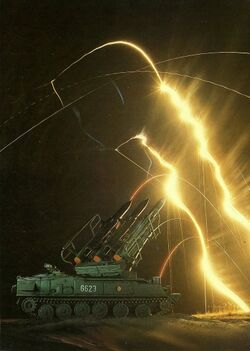Aerial warfare of the Refusal War
| Aerial warfare of the Refusal War | |||||||
|---|---|---|---|---|---|---|---|
| Part of the Refusal War | |||||||
 A Warden mobile SAM launcher. | |||||||
| |||||||
| Belligerents | |||||||
|
|
Mansuriyyah | ||||||
| Strength | |||||||
|
1,300 aircraft (peak) 4,285 air defense systems |
2,000 aircraft (peak) 2,322 air defense systems | ||||||
| Casualties and losses | |||||||
|
1,022 aircraft destroyed 1,736 pilots and crew killed |
1,842 aircraft destroyed 3,155 pilots and crew killed | ||||||
Aerial Warfare was a major component of the Refusal War, and for many involved parties was the primary means of intervention in the conflict. Air power was present in virtually every major operation of the war and was most often used to support the ground forces of their respective sides of the conflict. Additional applications of air power consisted of bombing campaigns against troop concentration, staging areas, and occupied urban areas. Aircraft on each side had to contend with ground based anti-air weapons including anti-aircraft artillery, surface-to-air missiles, and fire from small arms and personal weapons. Aerial engagements between the involved belligerents occurred regularly throughout the war, though the war only produced three aces. A total of 2,864 aircraft were shot down or otherwise destroyed during the war, with several hundred more lost to accidents.
Upon the outbreak of fighting the air force of the Republic of Syara, the Syaran Army Air Corps, disintegrated as pilots and formations chose sides, with a slight majority aligning with the Royalists. The Royalist air force was later supported by Acrea, Ossoria, and Mansuriyyah. Ruvelka supported the Royalists and allowed Acrean aircraft to be staged out of Ruvelkan air bases, but did not commit its own air force to the conflict. The Wardens were supported by Cacerta and Tennai. Although the involved foreign powers typically tried to avoid direct conflict with one another, occasional clashes between the external powers and their aircraft often heightened tensions between the belligerents.